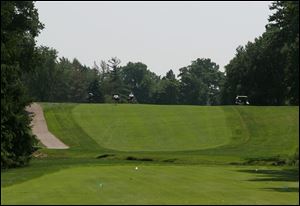
Highland Meadows has bevy of hide-and-seek holes
7/3/2005
Golfers climb the hill after hitting their tee shots at Farr Classic's No. 11 hole at Highland Meadows. From the tee, the landing area is out of view.
Imagine bowling without being able to see the pins.
Or, try serving a tennis ball without being able to see the court on the other side of the net.
Golf is as much a test of what you can t see as what you can, and there are few places where this is more the case than Highland Meadows Golf Club in Sylvania, the site of this week s Jamie Farr Owens Corning Classic.
Blind shots, they re called, where you can t see the fairway landing area from the tee or the green from the fairway.
The 80-year-old Meadows was Harold Weber s design gem. He was Toledo s first great amateur golfer and a founding member of Inverness Club, where he watched closely as the legendary Donald Ross renovated and added to the existing course in 1917-18.
There is much similarity between Inverness and Highland Meadows in some of the greens design with false fronts, shaved edges and subtle run-offs.
Ross also liked the occasional blind shot, such as the tee shot at Inverness 10th hole and the approach shot to his classic raised green at No. 7, one of the country s very best par 4s.
However, course changes at Inverness have eliminated some of Ross other blind alleys. The old No. 8, which no longer exists, was a risk-and-reward par 4, just 316 yards long, where big hitters of the era could try a blind shot over a rugged valley in an attempt to drive the green. The 17th hole used to feature a blind downhill approach shot until architect Arthur Hills, during a renovation prior to the 2003 U.S. Senior Open, shifted the fairway to the right and shaved the top of the hill descending to the green that opened up a sweeping view of the putting surface.
Weber watched Ross at work, often walking the course with the master designer during his on-site visits, and was surely influenced by his use of blind shots.
Weber, a four-time Ohio Amateur champion, later became a course architect and one of the earliest, and certainly the best, of his known efforts was the Meadows, which opened in 1925.
There, he became the master of the blind shot. No fewer than seven holes feature such shots, four of them from the tee box and three on approaches to greens.
There are more of them here, I think, than you ll find at most courses, said assistant pro Mark Bixler.
Highland Meadows members, of course, hardly even notice them.
You really don t think about it, said Dean Myers, who first joined the club in the late 1970s. There are certain trees you use as markers to line up with and then you hit to certain areas. But I imagine somebody new coming in who hasn t experienced it much would find those shots pretty tough. I m sure the lady pros have some trouble getting lined up right when they first get here.
Indeed, when rookies or first-time competitors arrive at the Meadows, the blind shots are something they always talk about.
That s when practice rounds and caddie help is really important, Bixler said.
Weber started the Meadows with two blind tee shots right off the bat. Remember, though, that the Farr Classic reverses the nines for tournament play, so our list of blind shots will go in the order the LPGA pros will play them.
Farr Classic director Judd Silverman won two district match play titles, one as a junior and another as an adult, at nearby Sylvania Country Club, which also features a bounty of blind shots.
I think anybody would rather be able to see the target and see where you want to land, he said. But good players, especially professionals, have such command of their shots and are so good with accuracy and playing to a distance that blind shots shouldn t bother them too much.